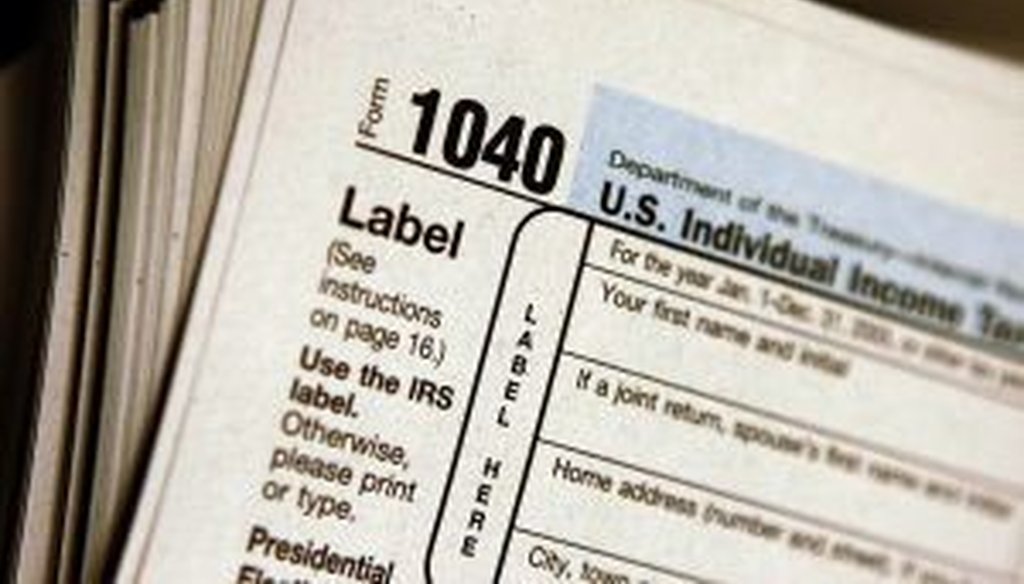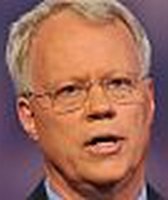Stand up for the facts!
Our only agenda is to publish the truth so you can be an informed participant in democracy.
We need your help.
I would like to contribute

Where do the candidates stand on taxes?
Taxes have been a major focus of this presidential campaign. Both President Barack Obama and Republican presidential nominee Mitt Romney have different ideas on the issue, and each has a specific tax plan.
Democrats have criticized Romney’s plan as being vague and a potential burden on middle-income families. Republicans have complained that Obama’s tax policies will keep the country mired in an economic slump.
Along the way, both men -- and their running mates, Vice President Joe Biden and vice presidential nominee Paul Ryan -- have kept the AJC Truth-O-Meter busy.
Below are abbreviated versions of fact checks about the candidates’ statements during the campaign. Look for the complete fact checks at the PolitiFact online sites.
Readers can comment on our Truth-O-Meter rulings at our Facebook page: www.facebook.com/politifact.georgia?fref=ts. And they can follow us on Twitter at: PolitiFactGA.
Obama: "Taxes are lower on families than they've been probably in the last 50 years."
In an interview with CBS’ "60 Minutes" that aired Sept. 23, Obama defended his economic policies of the past four years, including his tax policies.
Interviewer Steve Kroft noted that on the campaign trail, Romney has been saying that Obama is "crushing economic freedom with taxes, regulations and high-cost health care." Obama responded, "Yeah, well, it's a lot of rhetoric, but there aren't a lot of facts supporting it. Taxes are lower on families than they've been probably in the last 50 years. So I haven't raised taxes. I've cut taxes for middle-class families by an average of $3,600 for a typical family."
Since Obama said "probably in the last 50 years," we will be somewhat flexible on the time frame.
On the numbers, his statistic isn't exact, but it's pretty close -- average tax rates are in fact lower than most years in the past five decades, at least for the three income groups -- at one-half the median income, the median income and twice the median income -- we looked at.
The decline in average tax rates, however, was already under way under President George W. Bush, and the recession helped keep them low. We rate the claim Mostly True.
Romney: "President Obama has raised taxes 19 times."
Back in January -- an eternity in presidential campaign time -- in a Los Angeles Times article, a Romney campaign spokeswoman accused Obama of repeatedly raising taxes, "stunting our economic growth" and leading the country toward a European-style entitlement society.
Experts we checked with defined taxes as having the primary purpose of raising revenue for general government. And removing a tax exemption -- even if some critics call it a loophole and even if it benefits one company -- counts as a tax increase as long as the purpose is to generate revenue.
The Romney campaign’s list of Obama’s 19 tax increases included items that were clearly taxes: a higher federal excise tax on tobacco and a 10 percent excise tax on tanning services. Some of the taxes, specifically, those associated with health care services, have not yet taken effect.
There was strong argument that others on the list, such as a $50,000 penalty for nonprofit hospitals that don’t meet new community needs assessments, were not taxes.
One final note: The president doesn’t have the authority to raise taxes on his own. He can only do so with the consent of Congress, which is what happened in each of these cases.
Of the 19 provisions Romney is citing, we concluded that 13 may be reasonably defined as taxes (four are already in effect). Of the remaining six provisions, we found two that are subject to disagreement and four that are probably not taxes at all. On balance, we rated the statement Half True.
Obama: Said Romney "paid only 14 percent in taxes — probably less than you."
Obama made this claim during a summertime campaign ad this year to reinforce his depiction of Romney as a privileged rich guy who didn’t pay his fair share of taxes.
"You work hard, stretch every penny," a narrator says. "But chances are, you pay a higher tax rate than him: Mitt Romney made $20 million in 2010 but paid only 14 percent in taxes — probably less than you."
The 14 percent figure checks out. The 2010 tax return released by Romney and his wife, Ann, showed $3,009,766 in federal income tax paid on $21,661,344 in adjusted gross income -- an effective tax rate of 13.9 percent.
Looking at just income taxes, Obama is incorrect in what ordinary Americans pay. We can make an educated guess that perhaps 20 percent to 30 percent of taxpayers exceeded Romney’s tax rate for income taxes alone. That’s far from most, making the ad’s claim incorrect.
While we believe that including payroll taxes in the calculation offers a more accurate picture of what the American public pays the Internal Revenue Service, it's also true that the Obama ad didn't specify which measurement it was using, and in fact used a figure for Romney -- 14 percent -- that was based on income taxes alone. On balance, we rated the claim Half True.
Romney: "Forty-seven percent of Americans pay no income tax."
This infamous Romney claim began as a comment the Republican presidential candidate made to a group of wealthy donors at a high-dollar campaign fundraiser in Boca Raton, Fla. Romney told those in attendance that there’s a group of voters he believes he can never win over: people who pay no taxes.
Romney characterized this 47 percent of Americans as those who are "with [Obama], who are dependent upon government, who believe that they are victims. ... And they will vote for this president no matter what."
In checking Romney’s tax math, it's clear he is referring to federal taxes and his figure mirrors one from the Urban Institute-Brookings Institution Tax Policy Center, which found that in 2011, 46 percent of tax filers paid no income tax vs. about 54 percent of tax filers who did have some federal income tax liability. In 2009, the Tax Policy Center estimated the proportion who paid no taxes was 47 percent.
About half of people who don’t pay income taxes are simply poor, and the tax code explicitly exempts them.
We rated Romney’s statement True.
Obama: Said the Romney tax plan "could take away middle-class deductions for child care, mortgages and college tuition."
Both Obama and Romney are in a battle for the trust of the middle class, which most Americans say they are a part of and many swing voters fall into. Throughout the campaign both camps have targeted that group in their campaign ads.
An Obama ad from September called "Pay the bills" featured a woman named Christie who described an ordinary life of doing laundry, paying bills and caring for her kids. The ad said Romney’s tax plan "could take away middle-class deductions for child care, mortgages and college tuition."
Romney has said he would not reduce the mortgage deduction and has promised not to increase taxes on the middle class. He has failed, however, to provide enough details for analysts to model what his plan would actually do.
The Romney plan might be unrealistic and intentionally vague, but the Obama campaign filled in the blanks with specific deductions that would appeal to middle-class moms. Romney hasn't said he intends to take away those deductions. And he's specifically said he won't touch the largest of those deductions, the mortgage deduction for the middle class.
We rated the statement Mostly False.
Obama: The federal tax code has "loopholes that are giving incentives for companies that are shipping jobs overseas."
The first presidential debate sparked discussion on the taxes paid by companies doing business overseas. By one conservative estimate, this part of the tax code is worth $30 billion a year.
"I also want to close those loopholes that are giving incentives for companies that are shipping jobs overseas," Obama said. "I want to provide tax breaks for companies that are investing here in the United States."
Romney responded, "The idea that you get a break for shipping jobs overseas is simply not the case."
In the narrowest sense possible, Romney’s rebuttal is accurate. There is no clause in the tax code that rewards a company when it relocates production beyond U.S. borders. But if a plant moves at all, whether it’s from Ohio to Tennessee or Ohio to Malaysia, it is eligible for deductions.
Independent analysts agree that firms with international operations can take advantage of tax loopholes that domestic firms cannot. The value of these is in the billions. Such tax laws might not be the deciding factor for companies to locate in foreign countries, but they make that choice more lucrative.
We rated the statement True.
Ryan: "The Canadians — they (dropped) their tax rates to 15 percent. The average tax rate on businesses in the industrialized world is 25 percent."
During the one and only vice presidential debate, Ryan attempted to draw a contrast with Obama’s tax policies by invoking Canada as an example of a low-tax nation.
He is correct on both counts about Canadian and international tax rates. Since 1998, the central government corporate rate in Canada has declined from 29.12 percent to 15 percent. But it is worth pointing out that provincial taxes -- the equivalent of state corporate taxes in the U.S. -- boost Canada’s rate to 26.1 percent. Using the same data from a group of advanced industrialized nations, the average 2012 tax rates for the 34 countries studied is just slightly under 25 percent, as Ryan said.
The top U.S. corporate tax rate, including both federal and state taxes, is 39.1 percent. That’s higher than Canada’s, and since April, it has been the highest corporate tax rate on the books of any of the more than 30 countries studied.
Still, the actual tax rate paid by a company can be lower than the official rate due to deductions and exemptions. We rated Ryan’s claim Mostly True.
Biden: The 30 percent tax rate called for under Obama’s proposed Buffett Rule "is lower than the prescribed tax rate for millionaires already -- not just for millionaires, for people making over $200,000."
Biden toed the line for his running mate during an April speech in New Hampshire.
"No one who makes a million dollars or more in any single given year will pay at an effective tax rate that's less than 30 percent." Later, he added, "Anybody making a million dollars can't pay 30 percent in taxes? That's lower than the prescribed tax rate for millionaires already -- not just for millionaires, for people making over $200,000."
In the speech, Biden mixed and matched two different types of tax rates -- marginal tax rates, which refer to the rate paid on the last dollar of income, and effective tax rates, which refer to the percentage of income someone ultimately paid in taxes. When Biden says the rate required by the Buffett Rule "is lower than the prescribed tax rate for millionaires already," he’s comparing the percentage of income paid as taxes (the Buffett Rule) to a marginal tax rate ("the prescribed tax rate for millionaires already"). Making this comparison is mixing apples and oranges.
But if you look at the effective tax rates paid by the two groups he’s talking about, he’s right that millionaires already have an effective tax rate of at least 30 percent, assuming their income doesn’t include capital gains. But he’s wrong when he says that taxpayers earning $200,000 do. In fact, taxpayers would have to have much higher taxable incomes before facing that rate -- $617,000 for married couples and $465,000 for individuals.
Overall, Biden’s claim is a mixture of accurate and inaccurate information. We rated it Half True.
Our Sources
See original stories
















































